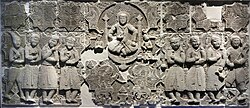Yemek
[2] Minorsky, citing Marquart, Barthold, Semenov and other sources, proposes that the name Kīmāk (pronounced Kimäk) is derived from Iki-Imäk, "the two Imäk", probably referring to the first two clans (Īmī and Īmāk) of the federation.
[13] However, Golden later changed his mind, reasoning that, as the Medieval Kipchak dialectal sound-change /k/ > ∅ had not yet happened in the mid-7th century Old Turkic, the identification of Yemeks with Kimeks is disputed.
[14] According to Tishin (2018), Yemeks were simply the most important of the seven constituent tribes whose representatives met at the Irtysh valley, where the diverse Kimek tribal union emerged, as related by Gardizi.
After the 840 AD breakup of the Uyghur Khaganate, the Yemeks headed a new political tribal union, creating a new Kimek state.
The Kimaks led a semi-settled life, as the Hudūd mentioned a town named *Yimäkiya (> Yamakkiyya > ms. Namakiyya); while the Kipchaks, in some customs, resembled the contemporary Oghuzes, who were nomadic herders.
In the eleventh to twelfth centuries a Mongol-speaking Naiman tribe displaced the Kimeks and Kipchaks from the Mongolian Altai and Upper Irtysh as it moved west.
Another part of the Nogai were deported from the Budjak steppes after Russian conquest of Western Ukraine and Moldova in the eighteenth and early nineteenth century.
[32] Sümer associates the Kimeks with the Chiks[33] (who were mentioned in Tang Huiyao[34][35] and Bilge Qaghan inscription[36]); however, Golden sees little evidence for this.
[40] A genetic study published in Nature in May 2018 examined the remains of Kimek male buried in Pavlodar Region, Kazakhstan ca.
